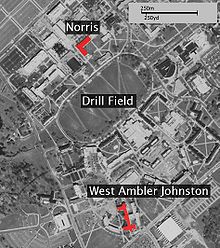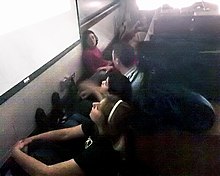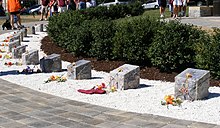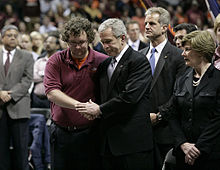Virginia Tech massacre
| Virginia Tech massacre | |
|---|---|
 Students gather to mourn after the shooting. | |
| Location | Blacksburg, Virginia, United States |
| Coordinates | 37°13′46″N 80°25′23″W / 37.22944°N 80.42306°WCoordinates: 37°13′46″N 80°25′23″W / 37.22944°N 80.42306°W |
| Date | Monday, April 16, 2007 ca. 7:15 a.m. and ca. 9:40 a.m.–9:51 a.m.[1] (EDT) |
| Attack type | School shooting, mass murder, murder-suicide, massacre |
| Weapon(s) | Glock 19, Walther P22 |
| Death(s) | 33 (including the perpetrator)[1] |
| Injured | 25[1] |
| Belligerent | Seung-Hui Cho |
Cho, a senior English major at Virginia Tech, had previously been diagnosed with a severe anxiety disorder. During much of his middle school and high school years, he received therapy and special education support. After graduating from high school, Cho enrolled at Virginia Tech. Due to federal privacy laws, Virginia Tech was not informed of Cho's previous diagnosis or the accommodations he had been granted at school. In 2005, Cho was accused of stalking two female students. After an investigation, a Virginia special justice declared Cho mentally ill and ordered him to attend treatment.[3] Lucinda Roy, a professor and former chairwoman of the English department, had also asked Cho to seek counseling.[4]
The attacks received international media coverage and drew widespread criticism of U.S. laws and culture.[5] It sparked intense debate about gun violence, gun laws, gaps in the U.S. system for treating mental health issues, the perpetrator's state of mind, the responsibility of college administrations,[6] privacy laws, journalism ethics, and other issues. Television news organizations that aired portions of the killer's multimedia manifesto were criticized by victims' families, Virginia law enforcement officials, and the American Psychiatric Association.[7][8]
The massacre prompted the state of Virginia to close legal loopholes that had previously allowed Cho, an individual adjudicated as mentally unsound, to purchase handguns without detection by the National Instant Criminal Background Check System (NICS). It also led to passage of the first major federal gun control measure in more than 13 years. The law strengthening the NICS was signed by President George W. Bush on January 5, 2008.[9]
The Virginia Tech Review Panel, a state-appointed body assigned to review the incident, criticized Virginia Tech administrators for failing to take action that might have reduced the number of casualties. The panel's report also reviewed gun laws and pointed out gaps in mental health care as well as privacy laws that left Cho's deteriorating condition in college untreated.[1]
Contents[show] |
[edit] Attacks
[edit] West Ambler Johnston shootings
Cho was seen near the entrance to West Ambler Johnston Hall, a co-ed residence hall that houses 894 students, at about 6:45 a.m. EDT.[1][10] The hall was normally only accessible to its residents via magnetic key card before 10 a.m. Cho's student mailbox was in the lobby of the building, so he had a pass card access after 7:30 a.m., but it is unclear how he gained earlier entrance to the building.[1]Cho shot his first victims around 7:15 a.m. in West Ambler Johnston Hall. At about that time, Cho entered the room that freshman Emily J. Hilscher shared with another student. Hilscher, a 19-year-old from Woodville, Rappahannock County, Virginia, was killed. After hearing the gunshots, a male resident assistant, Ryan C. Clark, attempted to aid Hilscher. Clark, a 22-year-old-senior from Martinez, Columbia County, Georgia, was fatally shot.[11][12] Hilscher remained alive for three hours after being shot, but no one from the school, law enforcement or hospital notified her family until after she had died.[13][14]
Cho left the scene and returned to his dormitory room. While police and emergency medical services units were responding to the shootings in the dorm next door, Cho changed out of his bloodstained clothes, logged on to his computer to delete his e-mail, and then removed the hard drive. About an hour after the attack, Cho was believed to be seen near the campus duck pond. Although authorities suspected Cho threw his hard drive and cell phone into the water, a search was unsuccessful.[15][16]
Almost two hours after the first killings, Cho appeared at a nearby post office and mailed a package of writings and video recordings to NBC News; the package was postmarked 9:01 a.m.[17] He then walked to Norris Hall. In a backpack, he carried several chains, locks, a hammer, a knife, two guns, nineteen 10- and 15-round magazines, and almost 400 rounds of ammunition.[1]
[edit] Norris Hall shootings
About two hours after the initial shootings, Cho entered Norris Hall, which houses the Engineering Science and Mechanics program among others, and chained the three main entrance doors shut. He placed a note on at least one of the chained doors, claiming that attempts to open the door would cause a bomb to explode. Shortly before the shooting began, a faculty member found the note and took it to the building's third floor to notify the school's administration. At about the same time, Cho had begun shooting students and faculty on the second floor; the bomb threat was never called in.[1][18] Within one or two minutes of the first shots, the first call to 9-1-1 was received.[19]According to several students, before the shooting began Cho looked into several classrooms. Erin Sheehan, an eyewitness and survivor who had been in room 207, told reporters that the shooter "peeked in twice" earlier in the lesson and that "it was strange that someone at this point in the semester would be lost, looking for a class".[20] Cho's first attack after entering Norris occurred in an advanced hydrology engineering class taught by Professor G. V. Loganathan in room 206. Cho first shot and killed the professor, then continued shooting, killing nine of the 13 students in the room and injuring two others.[1] Next, Cho went across the hall to room 207, in which instructor Christopher James Bishop was teaching German. Cho killed Bishop and four students; six students were wounded.[1] Cho then moved on to Norris 211 and 204.[19] In both of these classrooms, Cho was initially prevented from entering the classroom by barricades erected by instructors and students. In room 204, Professor Liviu Librescu, a Holocaust survivor, forcibly prevented Cho from entering the room. Librescu was able to hold the door closed until most of his students escaped through the windows, but he died after being shot multiple times through the door. One student in his classroom was killed.[21] Instructor Jocelyne Couture-Nowak and student Henry Lee were killed in room 211 as they attempted to barricade the door.[22]
| Victims |
| 1. Ryan Clark (22) Martinez, Georgia —senior in Psych/Biology/English |
| 2. Emily Hilscher (19) Woodville, Virginia —freshman in Animal Sciences |
| 3. Liviu Librescu (76) Ploieşti, Romania —professor of Engineering |
| 4. Minal Panchal (26) Mumbai, India —masters student in Architecture |
| 5. G. V. Loganathan (53) Erode, Tamil Nadu, India —professor of Engineering |
| 6. Jarrett Lane (22) Narrows, Virginia —senior in Civil Engineering |
| 7. Brian Bluhm (25) Louisville, Kentucky —masters student in Civil Engineering |
| 8. Matthew Gwaltney (24) Chesterfield County, Virginia —masters student in Environmental Engineering |
| 9. Jeremy Herbstritt (27) Bellefonte, Pennsylvania —masters student in Civil Engineering |
| 10. Partahi Lumbantoruan (34) Medan, Indonesia —PhD student in Civil Engineering |
| 11. Daniel O'Neil (22) Lincoln, Rhode Island —masters student in Environmental Engineering |
| 12. Juan Ortiz (26) Bayamón, Puerto Rico[23] —masters student in Civil Engineering |
| 13. Julia Pryde (23) Middletown, New Jersey —masters student in Biological Systems Engineering |
| 14. Waleed Shaalan (32) Zagazig, Egypt —PhD student in Civil Engineering |
| 15. Jamie Bishop (35) Pine Mountain, Georgia —German instructor |
| 16. Lauren McCain (20) Hampton, Virginia —freshman in International Studies |
| 17. Michael Pohle Jr. (23) Flemington, New Jersey —senior in Biological Sciences |
| 18. Maxine Turner (22) Vienna, Virginia —senior in Chemical Engineering |
| 19. Nicole White (20) Smithfield, Virginia —junior in International Studies |
| 20. Jocelyne Couture-Nowak (49) Truro, Nova Scotia —professor of French |
| 21. Ross Alameddine (20) Saugus, Massachusetts —sophomore in English/Business |
| 22. Austin Cloyd (18) Champaign, Illinois —freshman in Int'l Studies/French |
| 23. Daniel Perez Cueva (21) Woodbridge, Virginia —junior in International Studies |
| 24. Caitlin Hammaren (19) Westtown, New York —sophomore in Int'l Studies/French |
| 25. Rachael Hill (18) Richmond County, Virginia —freshman in Biological Sciences |
| 26. Matthew La Porte (20) Dumont, New Jersey —sophomore in Political Science |
| 27. Henry Lee (20) Roanoke, Virginia/Vietnam —freshman in Computer Engineering |
| 28. Erin Peterson (18) Centreville, Virginia —freshman in International Studies |
| 29. Mary Karen Read (19) Annandale, Virginia —freshman in Interdisciplinary Studies |
| 30. Reema Samaha (18) Centreville, Virginia —freshman in Urban Planning |
| 31. Leslie Sherman (20) Springfield, Virginia —junior in History/Int'l Studies |
| 32. Kevin Granata (45) Toledo, Ohio —professor of Engineering |
| Perpetrator (suicide) |
| 1. Seung-Hui Cho (23) Centreville, Virginia —senior in English |
Students, including Zach Petkewicz, barricaded the door of room 205 with a large table after substitute professor Haiyan Cheng and a student saw Cho heading toward them. Cho shot several times through the door but failed to force his way in. No one in that classroom was wounded or killed.[31][32][33]
Hearing the commotion on the floor below, Professor Kevin Granata brought 20 students from a nearby classroom into an office, where the door could be locked, on the third floor of Norris Hall. He then went downstairs to investigate and was fatally shot by Cho. None of the students locked in Granata's office were injured.[34]
Approximately 10–12 minutes after the second attack began, Cho shot himself in the head.[35] During this second assault, he had fired at least 174 rounds,[19] killing 30 people and wounding 17 more.[1][35] During the investigation, State Police Superintendent William Flaherty told a state panel that police found 203 live rounds in Norris Hall. "He was well prepared to continue...," Flaherty testified.[36]
During the two attacks, Cho killed five faculty members and 27 students before committing suicide.[37] The Virginia Tech review panel reported that Cho's gunshots wounded 17 other people; six more were injured when they jumped from second-story windows to escape.[1] Sydney J. Vail, the director of the trauma center at Carilion Roanoke Memorial Hospital, said that Cho's choice of 9 mm hollow point ammunition increased the severity of the injuries.[38] Conversely, due to the limited penetration depth of hollow point bullets, it is likely that Colman would have died had they not been used.[39]
[edit] Perpetrator
The Virginia Tech review panel's August 2007 report devoted more than 127 pages to Cho's troubled history.[1] At three years of age, Cho was described as shy, frail, and wary of physical contact.[40] While early media reports carried speculation by South Korean relatives that Cho had autism,[41] the review panel report dismissed this diagnosis.[42] In eighth grade, Cho was diagnosed with severe depression as well as selective mutism, a social anxiety disorder that inhibited him from speaking.[1][43][44] Cho's family sought therapy for him, and he received help periodically throughout middle school and high school.[1] Early reports also indicated Cho was bullied for speech difficulties in middle school, but the Virginia Tech review panel was unable to confirm this.[45] High school officials worked with his parents and mental health counselors to support Cho throughout his sophomore and junior years. Cho eventually chose to discontinue therapy. When he applied and was admitted to Virginia Tech, school officials did not report his speech and anxiety-related problems or special education status because of federal privacy laws that prohibit such disclosure unless a student requests special accommodation.[44]
The Virginia Tech review panel report faulted university officials for failing to share information that would have shed light on the seriousness of Cho's problems, citing misinterpretations of federal privacy laws.[50][51] The report also pointed to failures by Virginia Tech's counseling center, flaws in Virginia's mental health laws, and inadequate state mental health services, but concluded that "Cho himself was the biggest impediment to stabilizing his mental health" in college.[1]
Cho's underlying psychological diagnosis at the time of the shootings remains a matter of speculation.[52] However, the lack of speech that resulted in the diagnosis of selective mutism could have been an early indication that Cho was developing schizophrenia. One symptom of schizophrenia is what is known as "poverty of speech," referring to a marked deficit in the amount of talking the person engages in. In addition, Cho's manifesto provides evidence of both paranoid and grandiose delusions. Such symptoms are also associated with schizophrenia, and it has been argued that Cho was schizophrenic.[53]
Early reports suggested that the killings resulted from a romantic dispute between Cho and Emily Hilscher, one of his first two victims. However, Hilscher's friends said she had no prior relationship with Cho and there is no evidence that he ever met or talked with her before the murders.[54] In the ensuing investigation, police found a suicide note in Cho's dorm room that included comments about "rich kids", "debauchery", and "deceitful charlatans". On April 18, 2007, NBC News received a package from Cho time-stamped between the first and second shooting episodes. It contained an 1800 word manifesto, photos, and 27 digitally recorded videos, in which Cho likened himself to Jesus Christ and expressed his hatred of the wealthy.[17] He stated, among other things, "You forced me into a corner and gave me only one option...You just loved to crucify me. You loved inducing cancer in my head, terror in my heart and ripping my soul all this time".[55] Media organizations, including Newsweek, MSNBC, Reuters and the Associated Press, even raised questions and speculated the similarity between a stance in one of Cho's videos, which showed him holding and raising a hammer, and a pose from promotional posters for the South Korean movie Oldboy, a film based on the Japanese manga of the same name about a businessman who was kidnapped away from his wife and infant daughter by an unknown assailant and imprisoned in a small room for 15 years.[56][57][58] Investigators found no evidence that Cho had ever watched Oldboy, and the professor who made the initial connection to Oldboy had since discounted his theory that Cho was influenced by the movie.[59] The Virginia Tech review panel concluded that because of Cho's inability to handle stress and the "frightening prospect" of being "turned out into the world of work, finances, responsibilities, and a family," Cho chose to engage in a fantasy where "he would be remembered as the savior of the oppressed, the downtrodden, the poor, and the rejected."[1] The panel went further, stating that, "His thought processes were so distorted that he began arguing to himself that his evil plan was actually doing good. His destructive fantasy was now becoming an obsession."[1]
[edit] Responses to the incidents
[edit] Emergency services response
Police took nearly six minutes to enter the barricaded building. When they could not break the chains, an officer shot out a deadbolt lock leading into a laboratory; they then moved to a nearby stairwell.[10] As police reached the second floor, they heard Cho fire his final shot;[10][37] Cho's body was discovered in Jocelyne Couture-Nowak's classroom, room 211.[35]In the aftermath, high winds related to the April 2007 Nor'easter prevented emergency medical services from using helicopters for evacuation of the injured.[60] Victims injured in the shooting were treated at Montgomery Regional Hospital in Blacksburg, Carilion New River Valley Medical Center in Radford, Carilion Roanoke Memorial Hospital in Roanoke, Holston Valley Hospital in Kingsport, TN and Lewis-Gale Medical Center in Salem.[61]
[edit] University response
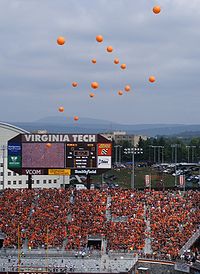
Within a day after the shootings, Virginia Tech, whose students call themselves The Hokies, formed the Hokie Spirit Memorial Fund (HSMF) to help remember and honor the victims. The fund is used to cover expenses including, but not limited to: assistance to victims and their families, grief counseling, memorials, communications expenses, and comfort expenses.[67] Early in June, 2007, the Virginia Tech Foundation announced that US$3.2 million was moved from the HSMF into 32 separate named endowment funds, each created in honor of a victim lost in the shooting. This transfer brought each fund to the level of full endowment, allowing them to operate in perpetuity. The naming and determination of how each fund will be directed is being developed with the victims' families. By early June, donations to the HSMF had reached approximately US$7 million.[68] In July 2007, Kenneth R. Feinberg, who served as Special Master of the federal September 11th Victim Compensation Fund of 2001, was named to administer the fund's distributions.[69] In October 2007, the families and surviving victims received payments ranging from $11,500 to $208,000 from the fund.[70]
Also early in June 2007, the university announced it would begin reoccupying Norris Hall within a matter of weeks. The building is used for offices and laboratories for the Engineering Science and Mechanics and Civil and Environmental Engineering departments, its primary occupants before the shootings. The building is to be completely renovated over time, and it will no longer contain classrooms.[71]
After the release of the Virginia Tech review panel report, some parents of those killed called for Virginia's governor to relieve the university president and campus police chief of their positions. However, Governor Tim Kaine rejected the notion, saying that the school officials had "suffered enough".[72]
[edit] Campus response
In the hours and days following the shooting, makeshift memorials to those killed or injured began appearing in several locations on the campus. Many people placed flowers and items of remembrance at the base of the Drillfield observation podium in front of Burruss Hall. Later, members of Hokies United placed 32 pieces of Hokie Stone, each labeled with the name of a victim, in a semicircle in front of the Drillfield viewing stand.[73]Tech students of South Korean descent initially feared they would be targeted for retribution.[74] While no official claims of harassment were made, anecdotal evidence suggests that some Korean students were affected.[75]
The shootings occurred as prospective students were deciding whether to accept offers of admission from colleges and universities. Despite this timing, Virginia Tech exceeded its recruiting goal of 5,000 students for the class of 2011.[76]
[edit] Government response
President Bush and his wife Laura attended the convocation at Virginia Tech the day after the shootings.[77] The Internal Revenue Service and Virginia Department of Taxation granted six-month extensions to individuals affected by the shootings.[78] Virginia Governor Tim Kaine returned early from a trade mission to Tokyo, Japan,[62] and declared a "state of emergency" in Virginia, enabling him to immediately deploy state personnel, equipment, and other resources in the aftermath of the shootings.[79]The incident also caused Virginia Commonwealth elected officials to re-examine gaps between federal and state gun purchase laws. Within two weeks, Governor Kaine had issued an executive order designed to close those gaps (see Gun politics debate, below). Prompted by the incident, the federal government passed the most significant gun control law in over a decade.[81] The bill, H.R. 2640, mandates improvements in state reporting to the National Instant Criminal Background Check System (NICS) in order to halt gun purchases by criminals, those declared mentally ill, and other people prohibited from possessing firearms and authorizes up to $1.3 billion in federal grants for such improvements.[82] Both the Brady Campaign to Prevent Gun Violence and the National Rifle Association supported the legislation.[83] The measure passed the United States House of Representatives on a voice vote on June 13, 2007. The Senate passed the measure on December 19, 2007. President Bush signed the measure on January 5, 2008.[82] On March 24, 2008, the U.S. Department of Education announced proposed changes in the regulations governing education records under the Family Educational Rights and Privacy Act (FERPA). Certain of the changes address issues raised by the Virginia Tech incident and are intended to clarify for schools the appropriate balance to strike between concerns of individual privacy and public safety.[84]
[edit] South Korean response
When the citizenship of the shooter became known, South Koreans expressed shock and a sense of public shame,[85] while the Government of South Korea convened an emergency meeting to consider possible ramifications. A candlelight vigil was held outside the Embassy of the United States in Seoul. South Korean President Roh Moo-hyun expressed his deepest condolences.[86] Although Cho was a second generation immigrant who came to the US as a third grader and was a permanent resident of the US, he was still considered a Korean due to his blood and thus caused South Koreans to collectively mourn and feel guilt.[87]South Korea's ambassador to the US and several Korean American religious leaders called on Korean Americans to participate in a 32-day fast, one day for each victim, for repentance.[88][89] The foreign minister, Song Min-soon, announced that safety measures had been established for Koreans living in the US, in apparent reference to fears of possible reprisal attacks.[90] A ministry official expressed hope that the shooting would not "stir up racial prejudice or confrontation".[91] No such incidents were ever reported.
Some Korean Americans criticized the fasting proposal, saying that it directed undue and irrelevant attention on Cho's ethnicity and not other, more salient, reasons behind the shooting. News reports noted that South Koreans seemed relieved that American news coverage of Cho focused on his psychological problems.[85] The Korea Tourism Organization (KTO) pulled its "Sparkling Korea" television advertisements off CNN after the shootings. A KTO official said it would be inappropriate to air the advertisements featuring images of Korea's culture and natural beauty in between the news reports of the rampage.[92]
[edit] Other responses
Some of Cho's family members expressed sympathy for the victims' families and described his history of mental and behavioral problems. Cho's maternal grandfather was quoted in The Daily Mirror referring to Cho as a person who deserved to die with the victims.[42] On Friday, April 20, Cho's family issued a statement of grief and apology, written by his sister, Sun-Kyung Cho.[97]
Many heads of state and international figures offered condolences and sympathy,[98] including Pope Benedict XVI,[99] Queen Elizabeth II, and UN Secretary-General Ban Ki-moon. Sporting teams and leagues at both the college and professional levels, as well as sports figures from football, baseball, basketball, hockey, soccer, and NASCAR racing, paid their respects and joined fundraising efforts to honor the victims.[100]
EQUITAS, a Canada-based "Strategic Rule of Law Think Tank" governed by international law, published a report pertaining to the Virginia Tech massacre which includes a review of measures for counter-terrorism and campus security adopted between 1993 and April 16, 2007.[101] The report criticizes Virginia Tech's institutional decision-making process and summarizes the lethal effects of failing to “implement and administer valid procedural and substantive safeguards aimed at securing the broad Va Tech and Blacksburg community against Level II type incidents involving acts of terrorism and mass casualties".[101] The report does not comment on gun control or mental health issues.
On July 30, 2007, after it came to light that Seung-Hui Cho had purchased on eBay two 10-round magazines for one of the guns used in the shootings, the online auctioneer prohibited the sale of firearms magazines, firearms parts, and ammunition components on its site.[102][103]
[edit] Continuing response
A Northern Virginia chapter, founded in November 2008 by Aaron Adler and Ethan Blonder, of the B'nai B'rith Youth Organization took on the name Liviu Librescu AZA, in honor of the Holocaust survivor who used his body to barricade Cho from entering his room.On September 4, 2009, the Marching Virginians took a 140 mile side-trip on their way to the season opening football game against the University of Alabama at the Georgia Dome in Atlanta. The 350 member band, 20 cheerleaders and members of the Corps of Cadets color guard performed at Lakeside High School, alma mater of Ryan Clark, along with the Lakeside Marching Band and visiting Evans High's band. The event was organized by Central Savannah River Area Virginia Tech alumni chapter to honor Clark's memory and as a fundraiser for a scholarship in his name.[104]
Beginning with the first anniversary of the attack and continuing since, the Queens' Guard of The College of William and Mary, another public university in Virginia, has memorialized the victims with an honor guard at the head of the College's Sunken Garden. The unarmed honor guard is modeled after the honor guard posted at the Tomb of the Unknowns by soldiers of the US Army's Old Guard.
[edit] Incident within gun politics debate
[edit] Virginia context
Law enforcement officials found a purchase receipt for one of the guns used in the assault among Cho's belongings.[107] The shooter waited one month after buying a Walther P22 pistol before he bought a second pistol, a Glock 19.[1] Cho used a 15-round magazine in the Glock and a 10-round magazine in the Walther.[108] The serial numbers on the weapons were filed off, but the ATF National Laboratory was able to reveal them and performed a firearms trace.[108]The sale of firearms by licensed dealers in Virginia is restricted to residents who successfully pass a background check.[109] Virginia law also limits purchases of handguns to one every 30 days.[110] Federal law requires a criminal background check for handgun purchases from licensed firearms dealers, and Virginia checks other databases in addition to the federally mandated NICS. A 1968 federal law passed in response to the assassinations of Robert Kennedy and Martin Luther King, Jr.,[83] also prohibits those "adjudicated as a mental defective" from buying guns. This exclusion applied to Cho after a Virginia court declared him to be a danger to himself in late 2005 and sent him for psychiatric treatment.[1][3] Because of gaps between federal and Virginia state laws, the state did not report Cho's legal status to the NICS.[3] Virginia Governor Timothy Kaine addressed this problem on April 30, 2007, by issuing an executive order intended to close those reporting gaps.[111] In August 2007, the Virginia Tech review panel report called for a permanent change in the Code of Virginia to clarify and strengthen the state's background check requirements.[1] The federal government later passed a law to improve state reporting to the NICS nationwide.[82]
[edit] Campus firearms ban
The shootings also renewed debate surrounding Virginia Tech's firearms ban. The university has a general ban on possession or storage of firearms on campus by employees, students, and volunteers, or any visitor or other third parties, even if they are concealed handgun permit holders.[112] In April 2005, a student permitted by the state to carry concealed handguns was discovered possessing a concealed firearm in class. While no criminal charges were filed, a university spokesman said the University had "the right to adhere to and enforce that policy as a common-sense protection of students, staff and faculty as well as guests and visitors".[113]In January 2006, prior to the shootings, legislator Todd Gilbert had introduced a related bill into the Virginia House of Delegates. The bill, HB 1572, was intended to forbid public universities in Virginia from preventing students from lawfully carrying a concealed handgun on campus.[114] The university opposed the bill, which quickly died in subcommittee. Virginia Tech spokesman Larry Hincker praised the defeat of the bill, stating, "I'm sure the university community is appreciative of the General Assembly's actions because this will help parents, students, faculty and visitors feel safe on our campus."[115]
[edit] Impact on state and local law
In August 2007, the Virginia Tech review panel report recommended that the state's General Assembly adopt legislation "establishing the right of every institution of higher education to regulate the possession of firearms on campus if it so desires" and went on to recommend campus gun bans, "unless mandated by law." The report also recommended gun control measures unrelated to the circumstances of the massacre, such as requiring background checks for all private firearms sales, including those at gun shows.[1] Governor Kaine made it a priority to enact a private sale background check law in the 2008 Virginia General Assembly, but the bill was defeated in the Senate Courts of Justice Committee.[116]The incident and its aftermath energized student activist efforts seeking to overturn bans that prevent gun permit holders from carrying their weapons on college campuses. Thirty-eight states throughout the U.S. ban weapons at schools; sixteen of those specifically ban guns on college campuses.[117] A new group, Students for Concealed Carry on Campus, formed after the massacre; as of March 2008, it claimed to have 16,000 members at 500 campuses nationwide.[118][119] Several states are weighing legislation to allow gun permit holders to carry concealed firearms on university campuses.[120] Another attempt by Delegate Gilbert to pass a law to allow concealed weapons on college campuses in Virginia was defeated in March 2008.[121]
[edit] Political response
The response to how gun laws affected the massacre was divided. According to a White House statement, "The president believes that there is a right for people to bear arms, but that all laws must be followed".[122] The Brady Campaign to Prevent Gun Violence said that it was too easy for an individual to get powerful weapons and called for increased gun control measures.[123]National Rifle Association board member Ted Nugent, commenting on CNN, called for an end to gun-free zones and contrasted the Virginia Tech massacre with other incidents in which mass shootings have been ended by law-abiding gun owners.[124] Texas Governor Rick Perry proposed that licensed gun owners be allowed to carry their weapons anywhere in Texas.[125]
Some government officials in other countries joined in the criticism of U.S. gun laws and policies.[5] For example, then Australian Prime Minister John Howard said that stringent legislation introduced after a 1996 mass shooting in Tasmania had prevented a problematic gun culture in Australia.[126]
Virginia Governor Tim Kaine condemned the gun politics debate following the massacre, saying, "To those who want to make this into some sort of crusade, I say take this elsewhere."[127]

